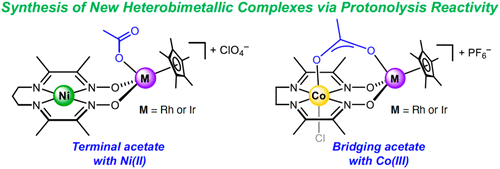当前位置:
X-MOL 学术
›
Inorg. Chem.
›
论文详情
Our official English website, www.x-mol.net, welcomes your feedback! (Note: you will need to create a separate account there.)
Incorporation of [Cp*Rh] and [Cp*Ir] Species into Heterobimetallic Complexes via Protonolysis Reactivity and Dioximato Chelation
Inorganic Chemistry ( IF 4.6 ) Pub Date : 2021-08-29 , DOI: 10.1021/acs.inorgchem.1c01362 Amit Kumar 1 , Chelsea G Comadoll 1 , Daniel S King 1 , Allen G Oliver 2 , Victor W Day 1 , James D Blakemore 1
Inorganic Chemistry ( IF 4.6 ) Pub Date : 2021-08-29 , DOI: 10.1021/acs.inorgchem.1c01362 Amit Kumar 1 , Chelsea G Comadoll 1 , Daniel S King 1 , Allen G Oliver 2 , Victor W Day 1 , James D Blakemore 1
Affiliation

|
The synthesis of multimetallic compounds can enable the placement of two or more metals in close proximity, but efforts in this area are often hindered by reagent incompatibilities and a lack of selectivity. Here, we show that organometallic half-sandwich [Cp*M] (M = Rh, Ir) fragments (where Cp* is η5-pentamethylcyclopentadienyl) can be cleanly installed into metallomacrocyclic structures based on the workhorse diimine–monooxime–monooximato ligand system. Six new heterobimetallic compounds have been prepared to explore this synthetic chemistry, which relies on in situ protonolysis reactivity with precursor Ni(II) or Co(III) monometallic complexes in the presence of suitable [Cp*M] species. Solid-state X-ray diffraction studies confirm installation of the [Cp*M] fragments into the metallomacrocycles via effective chelation of the Rh(III) and Ir(III) centers by the nascent dioximato site. Contrasting with square-planar Ni(II) centers, the Co(III) centers prefer octahedral geometry in the heterobimetallic compounds, promoting bridging ligation of acetate across the two metals. Spectroscopic and electrochemical studies reveal subtle influences of the metals on each other’s properties, consistent with the moderate M′···M distances of ca. 3.6–3.7 Å in the modular compounds. Taken together, our results show that heterobimetallic complexes can be assembled with organometallic [Cp*M] fragments on the diimine–dioximato platform.
中文翻译:

通过质子分解反应和二肟螯合将 [Cp*Rh] 和 [Cp*Ir] 物种结合到异双金属配合物中
多金属化合物的合成可以使两种或多种金属靠近放置,但该领域的努力往往受到试剂不相容性和缺乏选择性的阻碍。在这里,我们展示了有机金属半夹心 [Cp*M] (M = Rh, Ir) 碎片(其中 Cp* 是 η 5-pentamethylcyclopentadienyl) 可以干净地安装到基于主力二亚胺-单肟-单肟基配体系统的金属大环结构中。已经制备了六种新的杂双金属化合物来探索这种合成化学,它依赖于在合适的 [Cp*M] 物种存在下与前体 Ni(II) 或 Co(III) 单金属配合物的原位质子分解反应。固态 X 射线衍射研究证实 [Cp*M] 碎片通过新生二肟位点对 Rh(III) 和 Ir(III) 中心的有效螯合而安装到金属大环中。与方形平面 Ni(II) 中心相比,Co(III) 中心更喜欢异双金属化合物中的八面体几何形状,促进乙酸盐跨两种金属的桥接连接。光谱和电化学研究揭示了金属对彼此性质的微妙影响,与约的中等 M'…M 距离一致。3.6–3.7 Å 在模块化化合物中。总之,我们的结果表明异双金属配合物可以与有机金属 [Cp*M] 片段在二亚胺-二肟平台上组装。
更新日期:2021-09-20
中文翻译:

通过质子分解反应和二肟螯合将 [Cp*Rh] 和 [Cp*Ir] 物种结合到异双金属配合物中
多金属化合物的合成可以使两种或多种金属靠近放置,但该领域的努力往往受到试剂不相容性和缺乏选择性的阻碍。在这里,我们展示了有机金属半夹心 [Cp*M] (M = Rh, Ir) 碎片(其中 Cp* 是 η 5-pentamethylcyclopentadienyl) 可以干净地安装到基于主力二亚胺-单肟-单肟基配体系统的金属大环结构中。已经制备了六种新的杂双金属化合物来探索这种合成化学,它依赖于在合适的 [Cp*M] 物种存在下与前体 Ni(II) 或 Co(III) 单金属配合物的原位质子分解反应。固态 X 射线衍射研究证实 [Cp*M] 碎片通过新生二肟位点对 Rh(III) 和 Ir(III) 中心的有效螯合而安装到金属大环中。与方形平面 Ni(II) 中心相比,Co(III) 中心更喜欢异双金属化合物中的八面体几何形状,促进乙酸盐跨两种金属的桥接连接。光谱和电化学研究揭示了金属对彼此性质的微妙影响,与约的中等 M'…M 距离一致。3.6–3.7 Å 在模块化化合物中。总之,我们的结果表明异双金属配合物可以与有机金属 [Cp*M] 片段在二亚胺-二肟平台上组装。



























 京公网安备 11010802027423号
京公网安备 11010802027423号